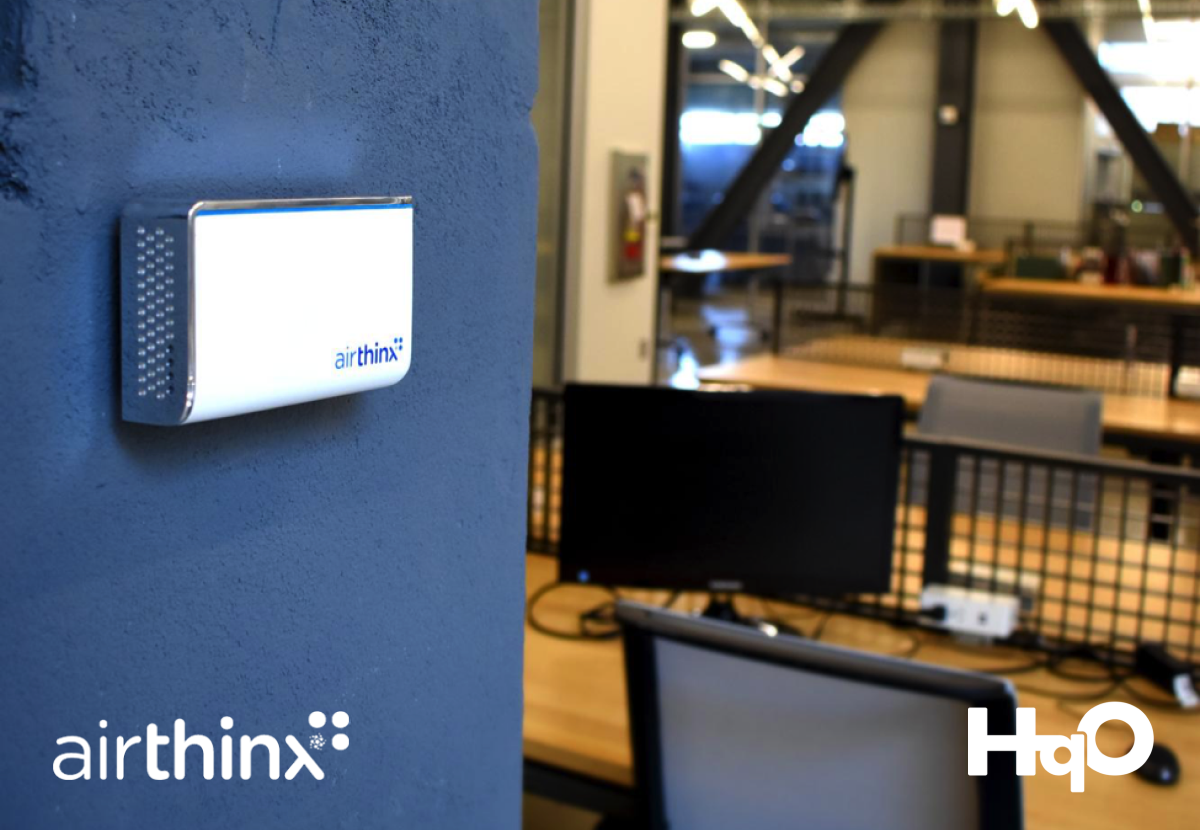Ever since the start of the COVID-19 pandemic, the importance of indoor air quality in the office has become even more apparent. As businesses search for solutions to fix the problems outlined by the CDC, many are missing the mark on what they should be doing to provide employees and customers with a safe workplace environment. As experts in air quality, we’ve outlined a few things to consider when returning to the office.
The COVID-19 Problem
The CDC has found that COVID-19 (along with many other viruses) are transmitted by exposure to airborne respiratory particles. While currently available air quality solutions (such as air purifiers) may be sufficient to mitigate indoor air quality risks, they lack the real-time monitoring and display functionality necessary to ascertain their effectiveness. On their own, these types of solutions represent a significant investment that delivers an unquantifiable return.
At Airthinx, we believe there are three steps in providing a complete solution to the problems brought about by the COVID-19 pandemic:
- Monitor: Collect indoor air quality data using high-end sensors to provide a view of the air quality in your building. It is important to use a device that continuously assesses the air 24/7, like the Airthinx IAQ, in order to correctly analyze the dynamic changes in the indoor environment.
- Remediate: Optimize current HVAC systems and supplement them with high-end air purifiers. These systems must be activated as necessary to resolve any air quality issues arising in the monitoring phase.
- Display: Delivering absolute transparency is a key part in building confidence with communities and allowing them to feel safe in your indoor space. Public displays and access to air quality data not only reinforce the safety of your environment, but also show the government and other local authorities that your building is actually healthy.
Reducing airborne health risks is a complicated challenge due to the dynamic nature of indoor air. Indoor air components are constantly changing as a result of daily life activities. Effectively managing air quality requires that all these variable elements be controlled simultaneously.
Indoor Air Quality Parameters

It is important that key indoor air quality (IAQ) parameters are monitored continuously based on their actual on-site status. By continuously monitoring and reporting these parameters, building managers can analyze air quality in real-time, resulting in a quicker response and more effective results.
Many of these parameters directly correspond to virus spread and can indicate the health of an indoor environment, such as CO2 providing insight into how well the ventilation system is working. Devices like the Airthinx IAQ can monitor and detect parameters associated with virus spread, including particulate matter (PM) like ultra-fine particles (the same particles associated with the airborne COVID-19 virus), giving you a clearer picture of what is in the air you are breathing.
Understanding these parameters can help building managers control, and effectively eliminate the conditions that would otherwise increase the spread of viruses and poor air quality in their workspace.
Building Systems and IoT

Monitoring is the first step in understanding the health of your indoor space; the next step is taking control of the indoor environment through technology that enables the seamless integration of real-time data with remediation processes and mechanical systems.
Currently, most building management systems (BMS) do not have an intelligent analytics aspect that would allow the system to perform continuous data analysis and enable real-time performance and air quality optimization. These systems require manual control and manual programming in order to make changes to the indoor environment. This has created an opening for solutions that can take the changing indoor environment into account, share data across systems, and allow for building automation to create healthier, more energy efficient workspaces.
The Internet of Things (IoT) can seamlessly connect systems and allow devices like air purifiers, air handlers, HVAC systems, and filtration units to benefit from the use of real-time air quality data. Airthinx’s Air Quality Management System has been developed to do exactly that, leveraging the power of IoT with continuous air quality monitoring.
By using multiple sources of data, and collecting data from all building systems, IoT platforms can provide a better picture of what the indoor environment in a building is like while eliminating human error and poor building optimization. There’s no doubt that the future of BMS systems lies in the pathway where IoT, building management, and environmental monitoring meet.
Building Confidence and Trust

Not only is it important to take care of air quality problems, but it is also important to prove they have been taken care of. Many businesses have been given the suggestion to improve their HVAC systems and install air purifiers; but without a method to monitor and display the air quality, nobody will know if the implemented systems are working.
Airthinx started with the slogan “See The Air You Breathe” because we realized the importance of visualizing the indoor environment. Public air quality displays, public access to air quality readings, certifications that your indoor environment is under control all help improve a business’ social impact and community support, while also verifying that the indoor air is controlled and healthy.
The Future of Dynamic Air Quality Control
As people around the globe come to the realization that current health risks are here to stay – and world leaders struggle with the challenge of balancing the conflicting interests of public health and the health of the economy – there remains an urgent need to fully (but safely) reopen businesses, return to workplaces, and rebuild community life. Reducing indoor health risks – such as transmission of viruses and the presence of toxins in the environment – is a complex challenge, but businesses must be prepared in case something like this happens again.
Businesses should be providing safe indoor environments for all occupants. The dynamic control of the constantly changing indoor air quality will play an important part in how businesses provide work conditions that meet and exceed the standards set by government institutions, and the desires of the general public. In addition to achieving the main goal of securing indoor health and safety, the systems must also demonstrate a high expected return on investment that is based on factors such as cost per site, potential savings, maintenance & energy costs, and the anticipated increase in revenues that will result from being able to achieve, maintain, and demonstrate the clean air status achieved.
Airthinx has already taken the important step of creating a platform where businesses can integrate our solution with their pre-existing mechanical systems, and provide immediate connection and control based on advanced algorithms, artificial intelligence, and machine learning. The ability to continuously detect and effectively remediate air quality issues, as well as report on air status in real time, makes solutions like Airthinx the only way to provide a complete response, enabling the reopening of closed environments to the public, a key step towards rehabilitating economies and communities.
If you would like to find out more about how we can help your business monitor & remediate air quality in real-time in order to provide a safer indoor working environment, please visit our website airthinx.io or contact us at [email protected].
The opinions expressed by HqO Guest Bloggers and those providing comments are theirs alone, and do not reflect the opinions of HqO, any subsidiary or affiliate of the same, or any employee thereof. Although the articles are thoroughly reviewed by HqO staff, the views, opinions and positions expressed within these guest posts are those of the author alone. The accuracy, completeness and validity of any statements made within each article are not guaranteed. We accept no liability for any errors, omissions or representations. The copyright of this content belongs to the author and any liability with regards to infringement of intellectual property rights remains with them.



